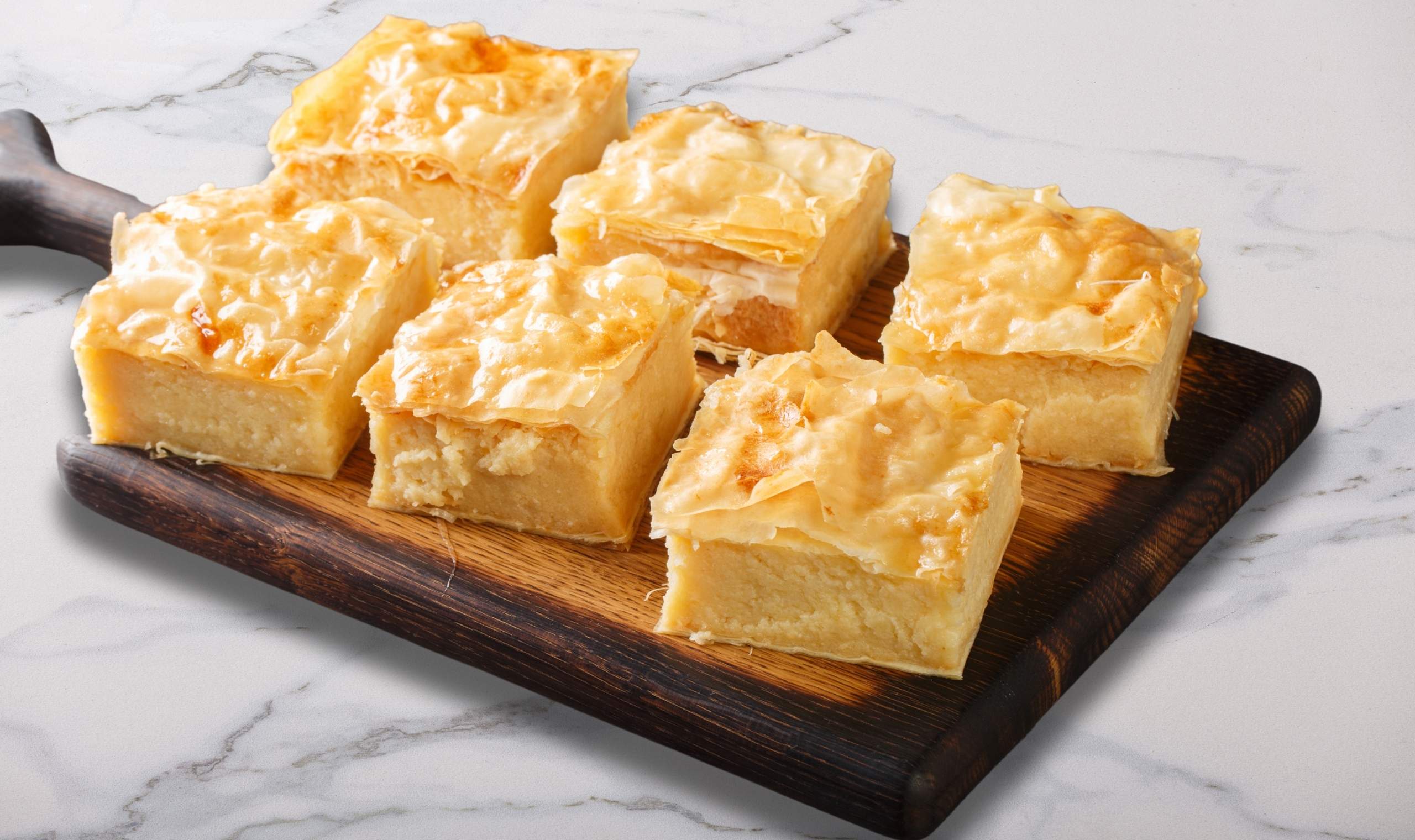Galaktoboureko: Greece’s Delectable Semolina Custard Pie
Origins of Galaktoboureko
Galaktoboureko, the renowned Greek semolina custard pie, has its roots deeply embedded in the rich culinary history of Greece. Tracing back to the Byzantine era, this dessert exemplifies the intricate interplay of flavors and cultural influences that characterize Greek cuisine. During this time, the pie began as a basic dish made from simple ingredients, primarily semolina, milk, and sugar, encased within layers of delicate phyllo pastry.
The History Behind Galaktoboureko
Galaktoboureko, a traditional Greek dessert, boasts a rich history that encapsulates the culinary evolution of Greece. The earliest references to this delectable pie date back to the Byzantine era, showcasing the significance of milk and semolina in ancient Mediterranean cuisine. As a dish rooted in the Hellenistic tradition, galaktoboureko originally emerged from the need to create an indulgent dessert that combined locally sourced ingredients.
The transition of galaktoboureko from Byzantine kitchens to contemporary Greek households is a reflection of the cultural exchanges that have shaped Greek gastronomy. With influences from the East introduced through trade routes, the use of phyllo pastry became prominent in many Greek desserts, including galaktoboureko. This combination of soft, creamy custard and flaky layers exemplified a fusion of textures that appealed to the palates of both royalty and common folk.
Throughout the centuries, galaktoboureko gained popularity across various regions of Greece. Each locality introduced its own twist on the classic recipe, often incorporating regional flavors and techniques. For instance, in parts of Thessaloniki, locals might add orange zest or cinnamon to the custard, which enhances the taste and aroma of the dish. Such variations not only highlight regional creativity but also the adaptability of galaktoboureko within different cultural contexts.
Literature and historical texts further underscore the significance of this beloved dessert. Renowned culinary figures have mentioned galaktoboureko in their works, celebrating its unique place in Greek dessert culture. From family gatherings to festive celebrations, this custard pie has become a symbol of Greek hospitality, often featured as a sweet ending to elaborate meals. As such, galaktoboureko stands not only as a testament to culinary artistry but also as a cherished heirloom of Greek heritage.
The Layers of Flavor: Ingredients and Preparation
Galaktoboureko, a traditional Greek dessert, showcases an exquisite interplay of flavors and textures, primarily derived from its key ingredients: semolina, phyllo pastry, and syrup. Each component contributes uniquely to the overall experience of this delectable semolina custard pie.
The star ingredient, semolina, is a coarsely ground wheat that lends a rich, hearty texture to the custard filling. When cooked with milk, sugar, and eggs, semolina transforms into a creamy base that is both luscious and light, offering a subtle nutty flavor that complements the sweetness of the syrup. This custard filling is essential in achieving the characteristic flavors of galaktoboureko, and thus, attention must be paid to the ratios of ingredients to ensure the right consistency.
Phyllo pastry, another crucial element, requires meticulous handling as it forms the delicate layers that envelop the custard. Traditionally, homemade phyllo is preferred; however, many modern recipes utilize store-bought phyllo for convenience without sacrificing authenticity. The preparation involves layering multiple sheets of phyllo, brushed generously with melted butter to create a crispy exterior. Each layer adds to the crunchy texture that offsets the creamy custard, resulting in a harmonious contrast of mouthfeel.
Syrup is often described as the pièce de résistance, drizzled or soaked into the baked galaktoboureko post-cooking. A simple mixture of sugar, water, and lemon juice, the syrup can vary in sweetness and aromatic complexity depending on the additions, such as vanilla or orange blossom water. The timing of this application plays a critical role; allowing the syrup to fully penetrate the layers ensures the dessert is moist without becoming soggy. Adapting traditional recipes with modern techniques allows for variations, but the essence of the dish remains steadfast in its rich semolina custard and flaky phyllo layers.
Recipes for Authentic Galaktoboureko
Galaktoboureko, a traditional Greek dessert, stands out for its rich custard filling and flaky pastry, typically made using phyllo dough. Here we present a collection of authentic recipes, blending both classic and innovative approaches to this delightful pastry. Each recipe includes a comprehensive list of ingredients, step-by-step instructions, along with some cooking tips to ensure even novices can master this exquisite dish.
Classic Galaktoboureko Recipe
Ingredients:
- 1 cup fine semolina
- 4 cups milk
- 1 cup sugar
- 3 large eggs
- 1 teaspoon vanilla extract
- 1 package phyllo dough (about 20 sheets)
- 1 cup melted butter
Instructions:
- In a saucepan, combine milk and sugar over medium heat, stirring until dissolved.
- Gradually add semolina, whisking continuously to avoid lumps. Cook until thickened, then incorporate the eggs and vanilla.
- Remove from heat and allow the custard to cool.
- Preheat the oven to 350°F (175°C).
- Layer about 10 sheets of phyllo in a greased baking dish, brushing each layer with melted butter.
- Spread the cooled custard over the phyllo, then cover with remaining phyllo sheets, again brushing each layer with butter.
- Bake for 45-50 minutes or until golden brown.
Innovative Variation: Chocolate Galaktoboureko
This twist on the classic recipe introduces a chocolate layer to the custard. Simply add 1 cup of melted dark chocolate to the custard before spreading it on the phyllo. Follow the same baking instructions and serve with a drizzle of chocolate sauce for an elegant presentation.
Successfully creating galaktoboureko relies on a balance of flaky texture and creamy filling. Whether choosing the traditional version or trying out a modern spin, these recipes open up a world of delightful taste in Greek desserts.
Cultural Significance and Celebrations
Galaktoboureko, a delectable semolina custard pie, holds a prominent place in Greek culture, symbolizing both hospitality and heritage. This traditional dessert is commonly prepared during special occasions, family gatherings, and religious celebrations, reflecting its significance in Greek society. Whether served at weddings, birthdays, or during the festive Christmas season, galaktoboureko often takes center stage on the dessert table, showcasing its popularity and the love associated with its preparation.
Family traditions surrounding the making of galaktoboureko are often passed down through generations. Many Greeks recall fond memories of their mothers or grandmothers skillfully layering phyllo pastry, creating the ideal crunch that complements the rich, creamy filling. These cherished moments in the kitchen not only foster familial bonds but also serve as a testament to the dessert’s importance in Greek culinary practices. Each family tends to have a unique recipe, sometimes incorporating personal touches or variations that reflect their regional influences.
During religious festivals such as Easter and Christmas, galaktoboureko is often featured as a symbol of sharing and celebration among family and friends. It is not uncommon for families to prepare large batches to share with neighbors and loved ones, emphasizing the values of generosity and hospitality intrinsic to Greek culture. Home bakers may even participate in competitions or community events, showcasing their skills while further solidifying the communal aspect of this beloved dessert.
The act of serving galaktoboureko transcends mere consumption; it is an invitation to share in the warmth of Greek traditions. In essence, this beloved sweet not only satisfies the palate but also nurtures the soul, serving as a delicious reminder of the rich cultural tapestry that defines Greece.
Galaktoboureko in Modern Greek Cuisine
The evolution of galaktoboureko within contemporary Greek cuisine showcases an intriguing blend of tradition and innovation. Traditionally, this beloved semolina custard pie is defined by its sweet, creamy filling encased in layers of crisp phyllo dough, all drenched in a fragrant syrup. However, modern gastronomy has seen chefs and bakers creatively reinterpret this classic dessert, introducing novel ingredients and techniques while maintaining its quintessential flavor profile.
Today, it is not uncommon to find variations of galaktoboureko that incorporate unexpected flavors such as citrus zest, chocolate, or even aromatic spices like cardamom and saffron. Restaurants and bakeries across Greece are experimenting with these new ingredients to enhance the depth of flavor without overshadowing the dish’s essence. For instance, some chefs may choose to infuse the custard with various liqueurs or serve it with unique cream toppings, transforming the way diners experience this delightful dessert.
Moreover, the presentation of galaktoboureko has also evolved. In many modern establishments, it is served individually as a petite dessert rather than as a whole pie, presenting a more refined culinary experience. This shift caters to contemporary dining preferences where portion-controlled servings are often more appealing. Additionally, restaurants are focusing on plating techniques that emphasize the textures and colors of the dessert, elevating galaktoboureko to an art form while paying homage to its rich history.
Overall, the integration of modern culinary techniques and diverse ingredient adaptations in the preparation of galaktoboureko reflects the dynamic nature of Greek gastronomy. This adaptability not only preserves the traditional essence of the dish but also invites a new generation of gastronomes to appreciate its historic significance and delightful taste.
Where to Find the Best Galaktoboureko
When it comes to locating the most delectable galaktoboureko, both Greece and international cities with a strong Greek influence offer an array of culinary options. In Greece, one of the premier destinations for authentic galaktoboureko is Athens. The traditional pastry shop, “Kritikos,” established in 1953, is renowned for its delicious variations of this beloved dessert. Their galaktoboureko is celebrated for its perfectly crispy phyllo layers and rich, creamy semolina custard, making it a must-try for anyone visiting the city.
Another noteworthy spot in Athens is “Zaharoplastio,” famous among locals for its generous portions and balanced sweetness. This establishment offers a unique twist on the classic recipe by infusing the custard with hints of citrus, adding a refreshing note to the dessert.
Outside the capital, in Thessaloniki, “Mikra Asia” serves a delightful galaktoboureko that features a thicker custard. Diners rave about the restaurant’s handmade phyllo dough, ensuring an indulgent experience. This city is also home to the popular “Kritikos Bakery,” which has earned a solid reputation for crafting traditional Greek pastries, including galaktoboureko that often features a touch of cinnamon—a nod to the regional variations.
For those unable to travel to Greece, many cities around the world boast excellent Greek bakeries. In New York City, “Kaya Bakery” specializes in a delectable galaktoboureko that is made entirely from scratch, maintaining the authentic flavors of the dessert. Additionally, “Patisserie Georgiades” in Melbourne is highly recommended for its rich and creamy custard pie, making it a favorite among locals and visitors alike.
Thus, whether you are in Greece or abroad, there are plenty of options available to savor the exceptional taste of galaktoboureko, each offering their unique spin on this delectable dish.
Food Jokes and Fun Facts about Galaktoboureko
Galaktoboureko, the beloved Greek dessert, is not just a treat for the taste buds but also a source of joy and laughter. To tickle your funny bone, here are a few lighthearted jokes inspired by this delightful semolina custard pie:
Why did the galaktoboureko get invited to all the parties? Because it knows how to sweeten the deal! And speaking of sweet, did you hear about the galaktoboureko that went to therapy? It couldn’t get over its flaky past!
Beyond laughter, galaktoboureko has a rich cultural history that is equally amusing. Originating from the Byzantine era, this delectable dessert has been enjoyed for centuries. The word itself, “galaktoboureko”, derives from the Greek “gala” meaning milk, and “boureki”, which can refer to a pastry. This etymology hints at the creamy, delightful filling that makes this pie a favorite among dessert lovers.
A fun fact about galaktoboureko is that it is often served with a generous drizzle of syrup, which can transform the dish from a simple dessert into an extraordinary experience. The syrup is usually made from sugar, water, lemon juice, and sometimes a hint of cinnamon, enhancing the sensory pleasure. Did you know that in parts of Greece, galaktoboureko is often made from scratch in large batches to be shared during family gatherings and celebrations? It is a dish that not only brings people together but often leads to spirited debates on who makes the best version!
With its rich layers of pastry and creamy filling, galaktoboureko reminds us that life, much like this dessert, is best enjoyed with a sense of humor and shared with loved ones. So the next time you bite into this Greek masterpiece, remember the lighthearted spirit it carries along with its deliciousness! Adding a bit of fun to your dessert experience can make every bite that much sweeter.
Community Insights and Personal Stories
Food has an incredible power to connect individuals and communities, often serving as a backdrop for cherished memories and family gatherings. Galaktoboureko, with its rich history and delightful taste, is no exception. In various Greek households, this delectable semolina custard pie is not merely a dessert but a vessel for tradition and love, passed down through generations. Many individuals recount nostalgic memories of helping their grandmothers prepare this exquisite dish, learning the delicate art of making the phyllo pastry, and patiently waiting for it to bake while breathing in the sweet aroma that fills the home.
We encourage our readers to share their personal anecdotes and family recipes featuring galaktoboureko. Perhaps you recall a festive occasion where this unique dessert stole the spotlight at the dinner table, sparking conversations and laughter among family and friends. Some may recollect holiday celebrations where the pie was a staple, reflecting the warm essence of sharing and togetherness. A simple dish can elicit a profound sense of community, evoking emotions tied to cultural heritage and personal relationships.
Additionally, local variations of galaktoboureko may be prevalent, showcasing regional ingredients or unique twists that have been embraced over time. If you have explored these delightful adaptations or have a cherished alternative recipe, contributing your insights can cultivate a greater sense of community engagement. Sharing these experiences fosters connections among readers who may discover similarities in their love for this classic dessert. As we create a collection of stories and memories surrounding galaktoboureko, we deepen our appreciation for this beloved pie and the bonds we share through food.



